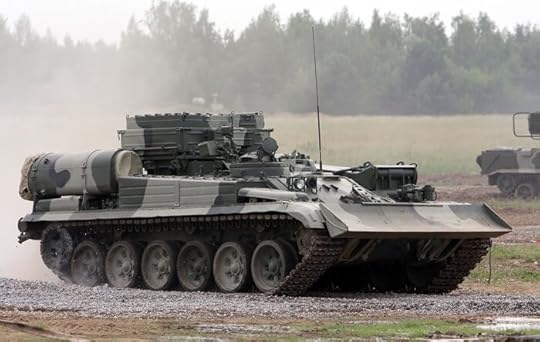The Soviet BREM-1 Armoured Recovery Vehicle

In contrast to the German army during the Second World War, the Soviet army did not have specialised recovery vehicles or tactics for using them. They started to experiment with their use at the end of the war, initially using locally-modified versions of existing vehicles, often turretless T-34s. After the war, they began producing dedicated vehicles with specialised equipment. One of these was the BREM-1, based on the chassis of the T-72 main battle tank.
BREM-1Introduced in 1984, the BREM-1 had a crew of three (driver,commander, and mechanic), all of whom were provided with day andnight-vision equipment. It had a top road speed of 60km/hour, a roadrange of 700km, and an off-road range of 500km. Towing another tanksignificantly reduced the range, to just 220km on roads. Like themain battle tank on whose chassis it was based, it had long-rangefuel drums at the rear of the vehicle, which could be jettisoned ifneeded. An unditching beam was mounted underneath the external fueldrums. A large-diameter snorkel was carried on the rear right of thevehicle, which could be used for deep wading at depths of up to 5m.
A crane was fitted on the left side of the vehicle. This had alift capacity of 19 tonnes when extended up to 2m, or 3 tonnes at themaximum extension of 4.4m. The crane was powered hydraulically,normally using power from the vehicle’s main engine to run the pump.If the main engine was not running, the vehicle batteries could powerthe crane via an electrical pump. The crane was controlled from anelevated position, with a full set of controls. The crane turntablecould be locked, and the vehicle could travel over level ground witha load suspended from the crane. When in transit, the crane wasfolded down along the side of the vehicle and secured in place with aclamp.
A full set of electric welding equipment, including a workingposition, was carried in a hermetically-sealed panel over the lefttrack. Special tools were carried in portable containers on a loadplatform. This load platform was located at the centre of the roof,and was 1.7m long and 1.4m wide. It had removable side panels, andcould carry a load of up to 1.5 tonnes.
The BREM-1 had two winches, a plough, a bulldozer blade, andtowing equipment. The mechanical main winch had a 200m cable and abasic capacity of 25 tonnes. Snatch blocks could be used to increasethis capacity to 100 tonnes. The winch was normally used at thefront, with the bulldozer blade to anchor the vehicle, but it couldalso be used to the rear for self-recovery.
The bulldozer blade was 3.1m wide and hydraulically driven, usingcontrols at the driver’s station. A BREM-1 could use this blade tocreate an MBT firing position in 12 to 20 minutes, depending on thestate of the soil.
For towing, the vehicle had a pair of 1.68m towing rods, with internal shock absorbers, and a pair of 5.5m towlines. Loads of up to 50 tonnes could be towed for prolonged periods, at the cost of greatly increased fuel consumption.
Other equipment included a 30-tonne capacity hydraulic jack,R-123U radio, tank telephone system, navigation system, and NBCprotection. Armour protection was the same as the T-72 MBT, althoughthe only armament was a 12.7mm NSVT machine gun with 840 rounds ofammunition. Four smoke-grenade dischargers were sometimes fitted, andall vehicles could create a smokescreen by injecting diesel fuel intothe exhaust manifold.
Specifications: BREM-1Crew: 3
Weight: 41 tonnes
Length: 7.98m
Width: 3.46m
Height: 2.43m
Ground clearance: 0.46m
Maximum road speed: 60km/hour
Maximum road range: 700km
Gradient: 60%
Vertical obstacle: 0.85m
Armament: 1x 12.7mm NSVT MG (840 rounds)
Image credit: Vitaly V. Kuzmin (CC BY-SA 4.0)



